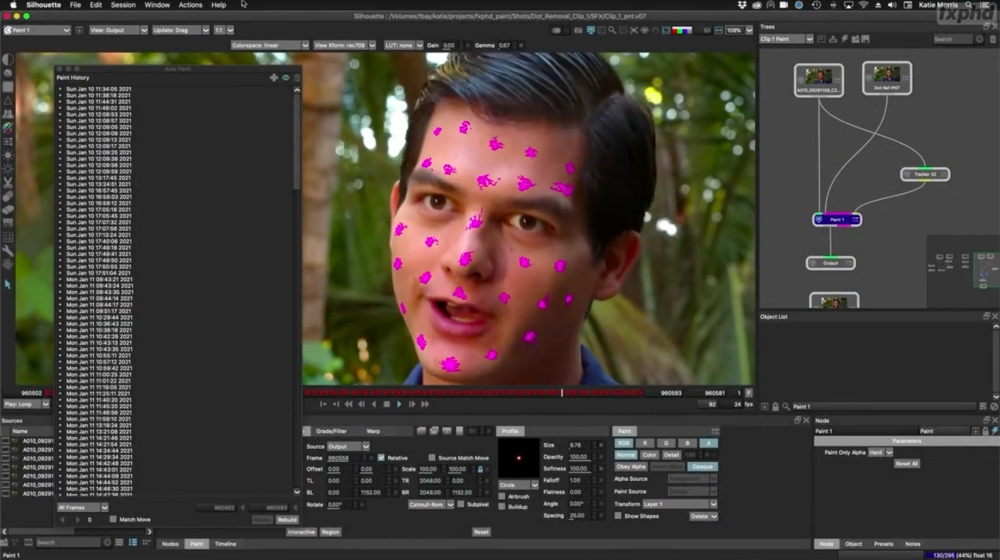Blender 2.91
Learning how to be a 3D artist involves understanding technique, workflow and best practices more than knowing specific programs. Sure, you can dive into Maya or Houdini or 3ds Max or Cinema 4D, etc. But as a budding artist, the cost of these programs may be out of your price range. This is where Blender comes in: It’s robust, full-featured, is actually used in production and it’s open source — which means it’s totally free.
Blender 2.91 is the latest build— and frankly, I’m a little embarrassed that I haven’t given it the attention that it deserves. The list of features is exhaustive, and ranges from modeling to sculpting to animation to cloth to volumes, to even things that other 3D programs have very little of: internal compositing, tracking, editing and 2D/3D hybrid drawing tools.
For me, a few of the brighter highlights in 2.91 are as follows: The Grease Pencil feature is designed to be for 2D animation, while existing in 3D space. The strokes become editable objects. And, traditional 2D tools like onion skinning provide a familiar workflow. New Grease Pencil features in 2.91 include the ability to import black and white images and convert them to Grease Pencil objects. Also, you can paint masks which will act as hold-outs between foreground and background animations.
Cloth tools had been introduced in earlier versions, but the developers have taken this feature further. Cloth sculpting has been made more robust by including collisions. Users already had ways to pull surfaces around to create wrinkles and buckling in cloth while retaining the surface area, but the collisions now allow one to drape cloth on characters.
There are also sophisticated FX with volumes where you can convert fluid volumes to meshes or vice-versa, meshes to volumes. And you can displace these volumes with procedural textures.
The list goes on and on. But, despite the fact that a Blender review is long overdue, and I’m glossing over just how powerful the program is, my primary reason for bringing it up now — in an issue focused on education — is how accessible it is. Everyone with a computer can use it, which means everyone can learn 3D (and 2D) animation without the expense of a software license. While there are many offers of educational or indie licenses of competing 3D programs — $750 can still be out of range for someone just starting out. Blender removes those limitations.
As a helpful hint that I frequently applied when I was first starting out, I would use tutorials from other software packages, and learn how to do them in the package I was using. For example: I had learned 3ds Max initially, so when Maya was released, I would use Max tutorials to force myself to rethink the approach and recreate it in Maya. Blender is as powerful as most other programs out there. There are hundreds of hours of training for it. But try looking at Maya or Cinema 4D or 3ds Max tutorials and try to recreate them in Blender. By doing so, you are learning the techniques and methodology of working in 3D, and not just where the correct buttons are in the software.
Website: blender.org
Price: Free!

Stan Winston School of Character Arts
Let’s step away from strictly animation and visual effects, at least from a digital perspective, and turn to the practical side of things: The special effects, the creatures, the miniatures and the puppets. In this world of CG domination, we sometimes lose track of our brothers and sisters who make things for real. These exceptionally talented artists have skills that have been groomed through apprenticeships and experience.
So, where would you go to learn these skills? If you go down to Best Buy and buy a computer, you have taken your first step to being a digital artist. All that is required now is 10,000 hours working on the computer. To actually fabricate a thing, there is a lot more involved. There is clay, silicone, machining metal, armature forging, and just so much more than popping open ZBrush and starting to sculpt.
Fortunately, the late Stan Winston — one of the kings of practical effects — has a namesake online School of Character Arts, which has hundreds of hours of training material covering everything from design to prosthetics to animatronics to wigs(!) to sculpting and beyond. The courses are taught by people who are actually doing it in films and television, and who are using the latest techniques. The brain trust is vast.
Similar to something like Pluralsight, you can search around for the exact tutorial you are looking for, but the real power lies in the Pathways, where you are led through a series of courses as a deep dive into a particular subject: Design, Fabrication, Eyes, Teeth, Mold Making, Model Making, Filmmaking, etc. I love this approach because you are learning it as a skill and a craft, rather than simply solving a problem.
Additionally, the community on the School’s site is active and and very responsive. The instructors interact with the students when they have questions. The students interact with each other. So, the knowledge isn’t coming strictly from the tutorials: You are getting feedback from your peers, just like school.
In fact, I am a member of the School not because I want to change my career and be a special effects (as opposed to visual effects) artist, but rather because I need to know what these guys can (and cannot) do, so that we can work together to benefit from each other’s strengths. The knowledge also allows me to understand the language of their world so I can better communicate.
For those on the digital side of things, you can learn a lot from actually making real things. Sculpting in clay gives you more understanding when sculpting in ZBrush. Designing wigs provides insight into grooming hair in XGen. Fabricating real clothes helps Marvelous Designer artists. Painting real miniatures helps texture artists. Not to mention how digital models work with 3D printers that provide pieces for the fabrication of special effects stuff, as well as the computer assistance when designing animatronics. There is much to learn!
Website: stanwinstonschool.com
Price: $19.99 (basic monthly), $59.99 (premium monthly), $359.94 (yearly)

FXPHD
It’s been a good five years since I’ve last done a review on FXPHD, and I have continued to be a paying member since then because I feel that the content is so good for VFX artists who are trying to up their game.
FXPHD works on a subscription model, where you have access to nearly all of the courses at any time for a monthly fee. These courses range from relative beginners to artists who have been in the field for years. And they span across a plethora of techniques (compositing, modeling, sculpting, animation, FX, environments, matte painting, editing, tracking, you name it) and across even more software packages (Maya, Nuke, Houdini, Cinema 4D, After Effects, ZBrush, Photoshop, Katana, Clarisse, RenderMan, etc., etc.,etc.).
There are also deep-dive masterclasses for Color Grading in Resolve for an additional cost. But believe me, they are worth it. Frankly, I feel that every VFX artist should go through at least a rudimentary course in color grading.
The courses are all taught by instructors who have been in and are still in the industry, using the same techniques in actual production workflows that they are teaching you. My favorite is probably Victor Perez, a VFX supervisor in Mexico whose knowledge is deep and his presentation is expansive. If you want to know more about pulling greenscreens than just throwing on a keylight and sampling the color, Victor explains not just what tools to use, but why — on a mathematical level — you choose to use those tools. And this kind of approach spans the courses — it’s not just about the how, it’s about the why.
Yes, the content is fantastic. Your FXPHD subscription provides you with a VPN license to many of the software packages you are learning about. Houdini and NukeX (as well as most other software) hold a hefty price tag if you are just starting to learn and you aren’t yet making money with your skillset. FXPHD provides you with the tools to learn. There are plenty of training sites on the internet, but I can’t think of any off the top of my head that provides this kind of benefit.
Recently, I supervised a 360 video shoot, which I knew nothing about. FXPHD was my first stop to get up and running on the techniques before the project got underway and I needed to at least look like I knew what I was doing. One of the courses partially taught by VFX veteran Scott Squires. (Look him up! He’s done a few things.)
So whether you are just starting out, or whether you are a years-long veteran, the industry never stops changing, and we never stop learning. FXPHD has been and will continue to be one of my primary sources to keep my skill set ahead of the curve.
Website: fxphd.com
Price: Starting $79.99 (monthly)
Todd Sheridan Perry is an award-winning VFX supervisor and digital artist whose credits include Black Panther, Avengers: Age of Ultron and The Christmas Chronicles. You can reach him at todd@teaspoonvfx.com.




 Win a Funko X Lilo & Stitch Prize Pack!
Win a Funko X Lilo & Stitch Prize Pack! 
